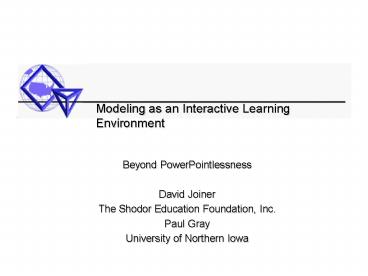Modeling as an Interactive Learning Environment - PowerPoint PPT Presentation
Title:
Modeling as an Interactive Learning Environment
Description:
Modeling as an Interactive Learning Environment. Beyond PowerPointlessness. David Joiner ... Modeling technology. Scientific Visualization ... Modeling in Education ... – PowerPoint PPT presentation
Number of Views:61
Avg rating:3.0/5.0
Title: Modeling as an Interactive Learning Environment
1
Modeling as an Interactive Learning Environment
- Beyond PowerPointlessness
- David Joiner
- The Shodor Education Foundation, Inc.
- Paul Gray
- University of Northern Iowa
2
Outline
- How has computing changed the landscape of
science education? - Have Shodor and NCSI been effective landscapers?
- Incorporating computing into education
- Parallel computing in computational (science
education) - Parallel computing in (computational science)
education
3
What is Shodor?
- Nonprofit education and research corporation
dedicated to the reform and improvement of math
and science education at all levels - Computational technology
- Communication technology
- Modeling technology
- Scientific Visualization
- Numerical methods and simulations integrated with
curriculum
4
What is NCSI?
- Faculty and teacher training outreach activity of
Shodor and its partners, revitalizing education,
integrating technology and curriculum, through
hands-on exploration of - Computational science
- Numerical models
- Data visualization tools
- Funded in part by National Science Foundation,
Division of Undergraduate Education, NCSI offers
- In-person workshops
- Web-based workshops
- Seminars
- Other support activities
5
New Careers...
6
...Require More Than Just Training
7
Keeping Things Fresh
8
Information Overload
9
Embedded Technologies
10
Inevitability of Change
11
Prophetic Vision
12
Modeling in Education
Modern science and mathematics are more properly
concerned with pattern recognition and
characterization than with mere symbol
manipulation.
13
Types Of Models
- Mental Models
- Physical Models
- Animal Models
- Agent Models
- Data Models
- Mathematical Models
- Numerical Models
14
(Computational Science) Education
Writing Models
Modifying Models
Pre-built Models
Modeling Environments
Spreadsheets
Math Formulation
Hand-waving
15
Computational (Science Education)
- Observations
- accurately recorded
- honestly reported
- assumptions
- biases
- Conjectures
- what if?
- consistent vs. conclusive?
- Collaborations
- peers
- mentors
- experts
- Choosing the right
- tools
- techniques
- technologies
- Facilitate hypothesis BUILDING at the right time
- Experiments Learn-by-doing numerical, visual
investigations - Differences between Observations and Conclusions
16
Is It Working?
- NCSI Summer 2002
- 85 faculty members
- 6 introductoy faculty workshops
- NCSI Summer 2003
- 250 faculty members
- 150 different institutions
- 15 faculty workshops
- Introductory
- Intermediate
- Chemistry
- Parallel computing
- Teacher training
17
Is It Working?
- NCSI 2003
- 38 minority representation
- 20 Black-African American
- 4 Hispanic
- 14 Asian
- 37 Female
18
A New Generation of Professionals
19
Students - 2001
20
Interns - 2001
21
Students - 2001
22
Interns - 2001
23
Durham
24
Is It Working?
- Computational science programs at UNI and across
the country - The UNI Computational Science Outreach Program
and new Bioinformatics major - Training of undergraduate students for Higher Ed.
- Wofford College
- Oregon State
- NCSA CSE Group
- Krell Institute
25
Example 1 A Forest Fire
- Web applet
- Freely available
- Simple Fire - 700 downloads per month
- (Middle school math materials see 35000 users
per month) - http//www.shodor.org/interactivate/activities/fir
e1/
26
Example 2 Mandelbrot Set
- z zzc
- Rules for addition, multiplication found in
Mandelbrot set - http//www.shodor.org/master/fractal/software/
27
Example 3 GalaxSee
- Windows/Mac/Java/Unix versions
- http//www.shodor.org/master/galaxsee
- N-Body problem
- Orbits
- Galactic structure
28
Why Parallel in Education?
- Increasing power needed to treat non-linear
problems realistically - OSCER - Boomer (Top 500 134)
- climateprediction.net
- Earth Simulator (Top 500 1)
29
Why Parallel in Education?
- Computational (Science Education)
- GalaxSee
- 100s of bodies
- angular momentum
- 100s of MFlops to view in real time
- 1000s of bodies
- needed for fluid appearance
- spiral structure NOT due to initial random
distribution of matter - 10000s of MFlops to view in real time
- 1000000s of bodies
- complex physics (collisions, dark matter, gas and
dust) - weeks, months on worlds fastest machines
30
Why Parallel in Education?
- Computational (Science Education)
- GalaxSee
- High communication requirements.
- Advanced algorithms, collective communication
needed for optimization - For test cluster (4 iBooks, YDL, 10Mbs hub) 500
body model slower on 4 nodes than on 1. - Better efficiency at larger model sizes, but take
longer to run.
31
Why Parallel in Education?
- (Computational Science) Education
- Computational Science for Computer Science
- Natural extension to core CS topics relating to
- Schedulers
- Memory addressing
- Semaphores and Mutexes
- Algorithmic Complexity
- Numerical Analysis
- Computer Architecture
- Computer Organization
- System Administration
- ...
32
How can parallel computing be used in education?
- Curricular Standards (undergraduate)
- IEEE/ACM Computing Curricula 2001, for Computer
Science - AL.11 Parallel Algorithms (CS 314)
- AR.9 Parallel Architectures (CS 321)
- CN.4 High Performance Computing (CS 222w)
- Net-Centric Computing (CS 230)
- SE.12 Specialized Systems Development (elective)
33
How can parallel computing be used in education?
- Specific ways of getting HPC into the curriculum
- You need some HPC resources.
- Build your own, from scratch.
- OSCAR (http//oscar.sourceforge.net)
- NPACI Rocks (http//rocks.npaci.edu/Rocks/)
- Bootable Cluster CD (http//bccd.cs.uni.edu)
- See Henry for OSCER access
- allocations_at_ncsa.uiuc.edu
34
How can parallel computing be used in education?
- HPC Curricular Emphasis doesn't have to be
isolated.
Cross Discipline
Higher Education
Research
Industry
Undergraduate CS Education
35
What Resources are Available?
- Faculty training
- OU Symposium
- NCSI Workshops
- Week-long summer workshops
- Assorted workshops w/ SC, Sigma Xi, CCSC, others
- http//www.computationalscience.org
- Materials
- Computational Science Education Reference Desk
- http//www.shodor.org/cserd
- Bootable Cluster CD Project
- http//bccd.cs.uni.edu































